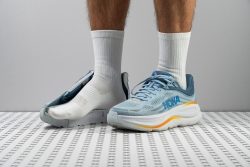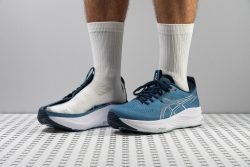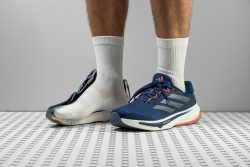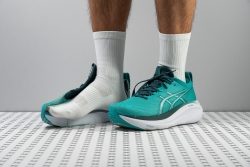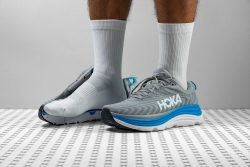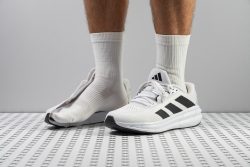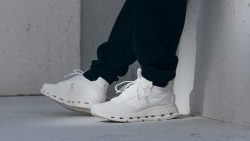7 Best Walking Shoes For Plantar Fasciitis in 2025
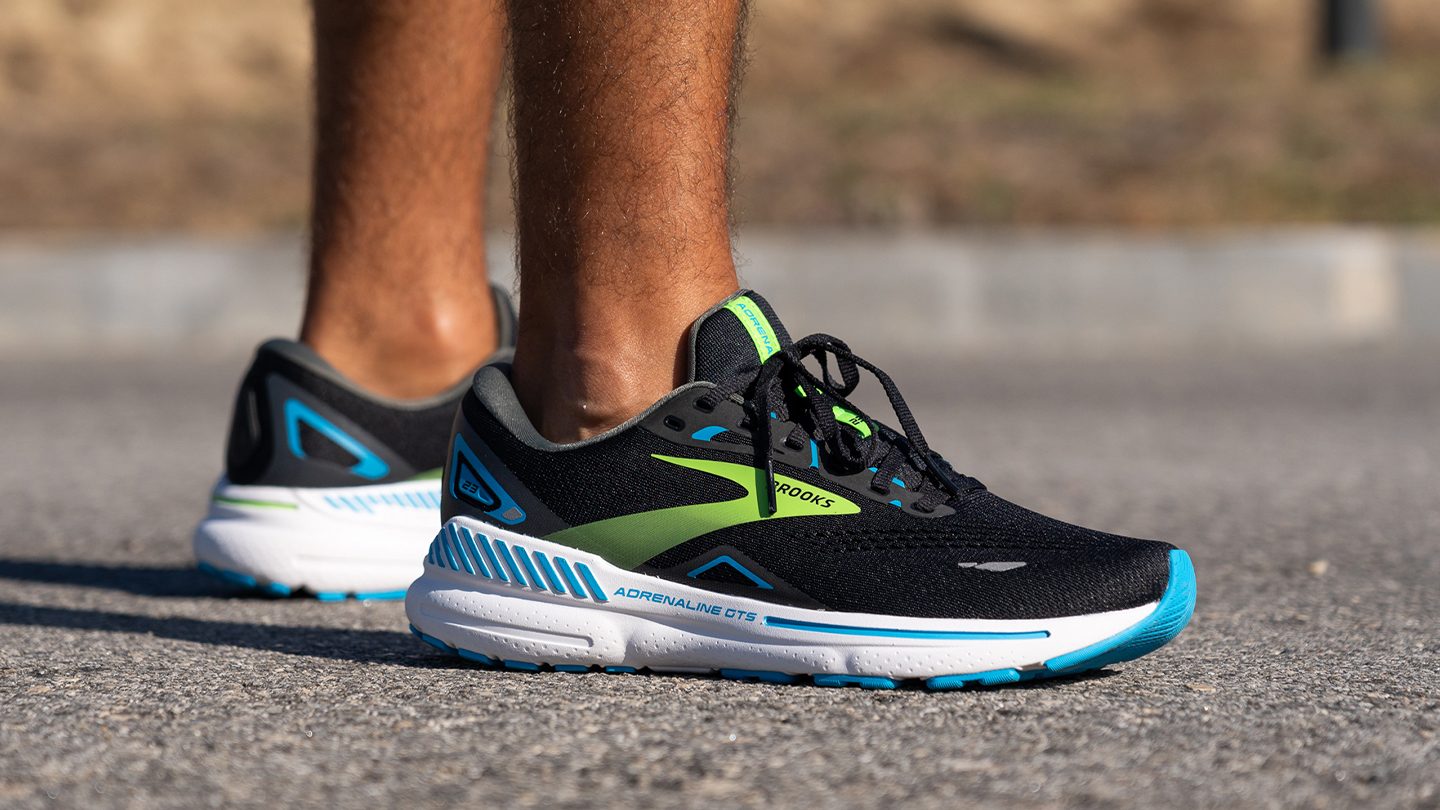
We buy shoes ourselves. We earn commissions when you buy through us, at no extra cost. Why trust us
Your feet deserve better than the stabbing pain in the heel area. Finding the right shoes is the #1 step to stand in the way of this. Our guide goes in-depth on which shoes are best for plantar fasciitis, why they are different from other shoes, and what science has to say.
We have reviewed walking shoes from every major brand to find the best options for this condition. Some shoes are better suited for people with wide feet, some feel extra light, and some offer extra slip resistance on smooth surfaces. See our top picks across different categories!
Disclaimer: This guide was created for educational purposes only and offers no medical advice or diagnosis.
How we test walking shoes for plantar fasciitis
Foot issues are something that we, at RunRepeat, take seriously. Walking might be an effortless form of motion, but with plantar fasciitis, a lot could go wrong even after a few hours of walking in the wrong pair of shoes.
Before anything else, we buy walking shoes with our own money. We emphasise this because we like our reviews to be completely fair and bias-free. After getting the shoes, we bring them on our morning walks, trips to work and walks around the city. Depending on their outsoles, we also test them on concrete, cobblestones, and other surfaces.
Then, we move to the lab tests. We cut shoes in half and assess and measure different features like shock absorption, breathability, durability, platform width, and traction. Once done, we publish a shoe review that combines results from our wear tests and lab tests.
Best overall walking shoes for plantar fasciitis
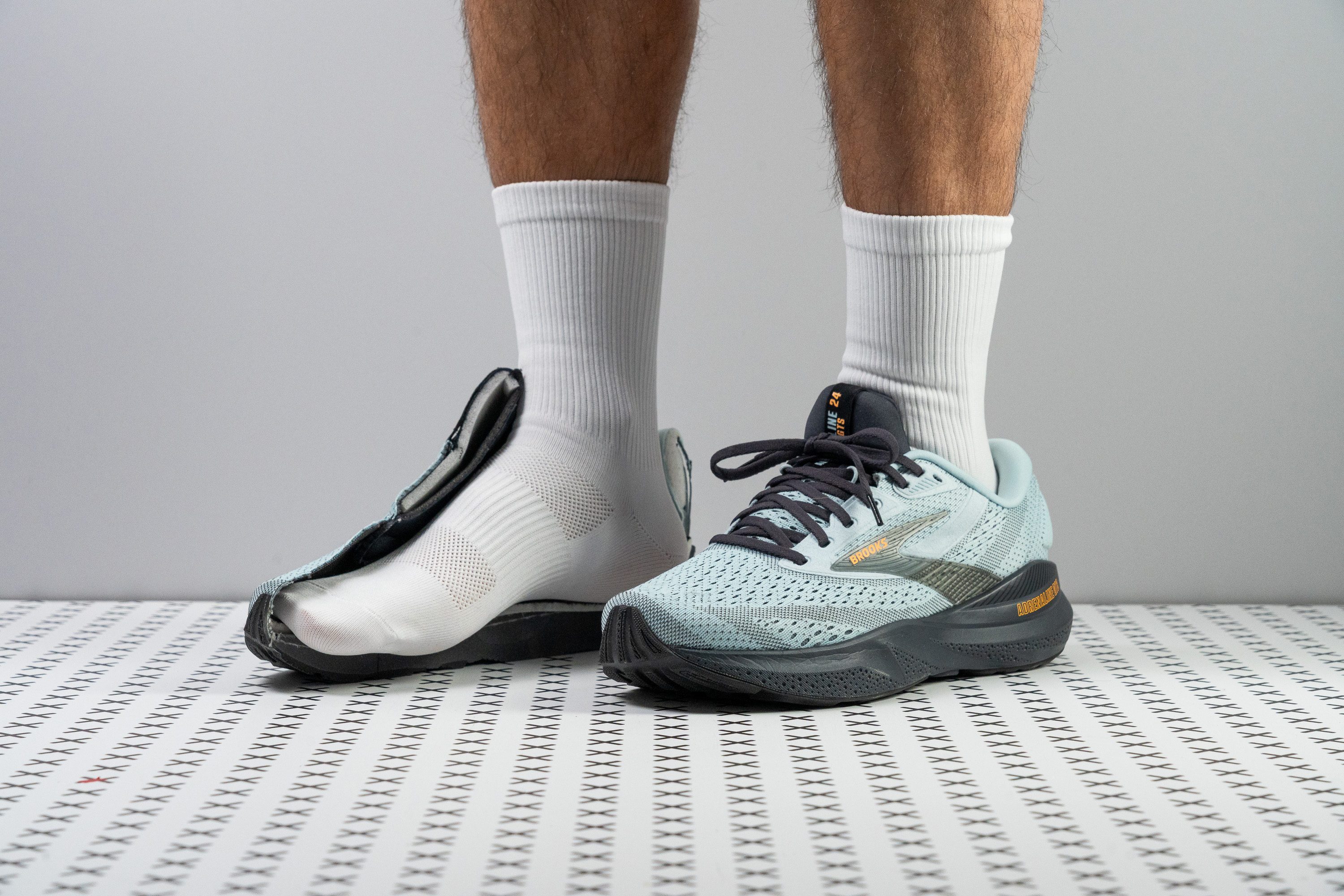


















































What makes it the best?
The Brooks Adrenaline GTS 24 is our Go-To Support shoe on days we want to stroll around feeling sure-footed and secure. In the lab, we discovered the GuideRails technology, adding structure to the shoe without losing the longitudinal flexibility needed for comfort. Add its reliable grip underfoot, and it takes the lead among plantar fasciitis walking shoes.
After careful observation in the lab, we noted that the GuideRails extend on both sides of the shoe, creating a bathtub-like fit with the raised midsole walls. It keeps our foot centred and prevents excessive side-to-side movement, proven by its solid 4/5 torsional rigidity score in our manual assessment.
The grippy base offers confidence even in wet conditions, proven by its high 0.48 traction score in our lab test. With a reliable grip, we could take control of each step.
Despite its sturdy stability, Adrenaline GTS 24 offers room for bending our feet freely, which keeps the ride smooth and natural. In our bend test, it even emerged 32.7% more flexible than average, enhancing its comfort for long hours of wear.
A small complaint we have is the non-gusseted tongue. We recommend securing this properly for a more seamless experience.
Pros
- Stack height upgrade!
- Reliable support
- Breathable mesh with oversized vents
- Price remains unchanged
- Available in 4 width options
- Good durability
- Plush tongue for top comfort
- Ideal for heel strikers
- Foam upgrade to DNA Loft v3
Cons
- Firmer-than-expected midsole
- High drop may feel too steep
- Toebox height is a bit low
- Non-gusseted tongue
Walking shoes for plantar fasciitis with the best shock absorption
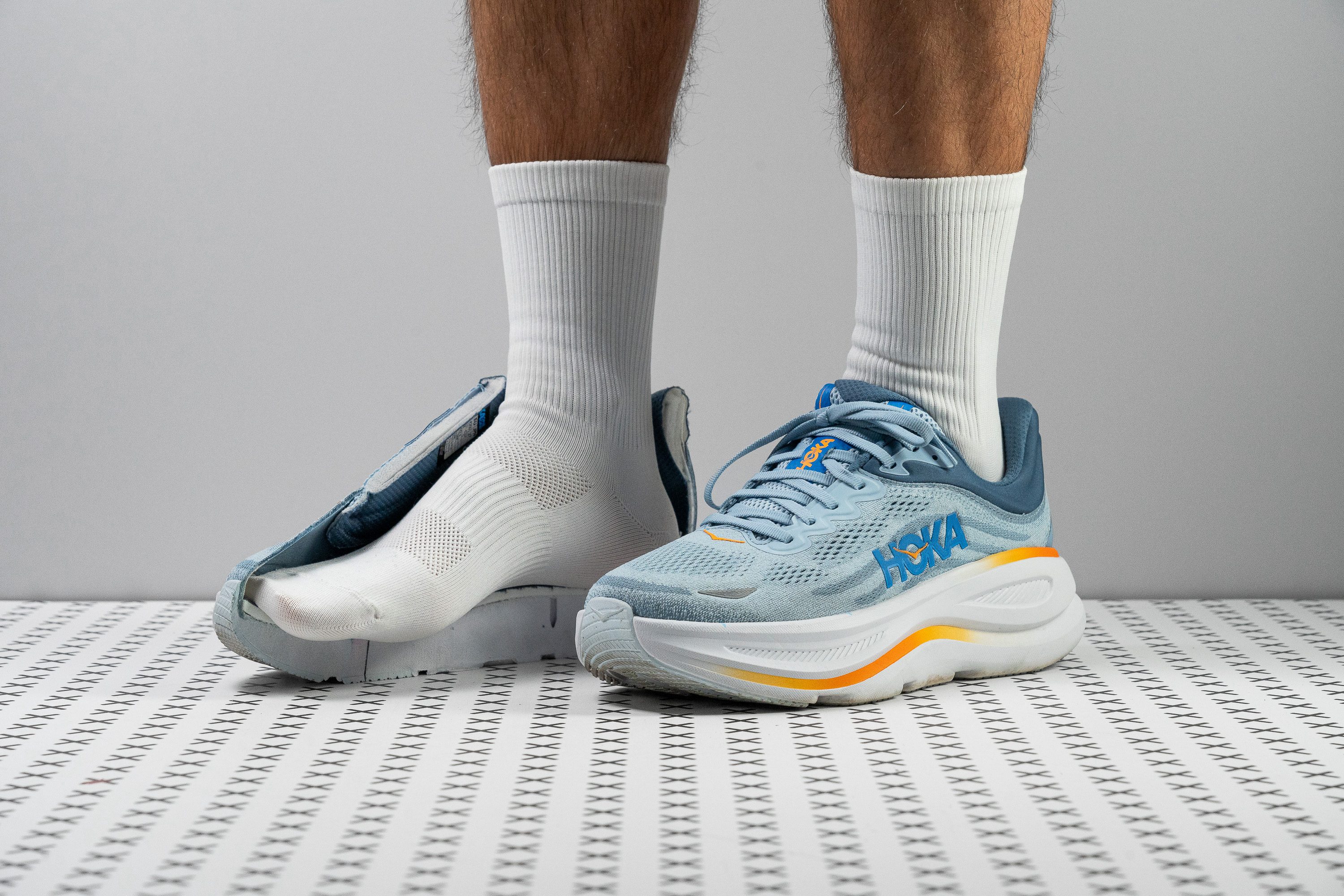



















































What makes it the best?
Comfort and stability seem polar opposites, but our walks with the Hoka Bondi 9 prove otherwise. Altogether, the ride is freeing since we don’t have to worry about potential imbalances and foot pain. Delivering reliable arch support and superior leg protection, it’s our top shock absorption walking shoe in the lab for those dealing with plantar fasciitis.
The heel emphasises cushioning at 41.3 mm, 7.0 mm above average. Each step feels highly protected since the midsole absorbed the impact. Our shock absorption test confirms this with a high 146 SA rating, which means it’s able to soften landings more vs. the 127 SA average.
The wide heel gave us room to find our footing securely, enhancing steady strides. Our calliper confirms it’s at 104.2 mm, a mind-blowing 13.5 mm above average! Besides this, it has raised sidewalls for a secure foothold and increased rigidity to avoid excessive movements that may lead to injuries. Our manual assessment verifies the stiffness with a 4/5 torsional rigidity rating.
Unfortunately, all the support made it a heavy 10.7 oz (303g) shoe. Those seeking a lightweight experience should look for alternatives.
Pros
- Endless cushioning
- New supercritical EVA midsole
- Amazing step-in comfort
- Doubles as a walking shoe
- Stable for its height
- Built to last
- Excels at slow-and-steady paces
- Well-designed heel collar
- Lighter than v8
Cons
- Not for wide feet
- Still feels heavy and clunky underfoot
- Drop measurement differs from stated
- Non-gusseted tongue
Walking shoes for plantar fasciitis with the best stability
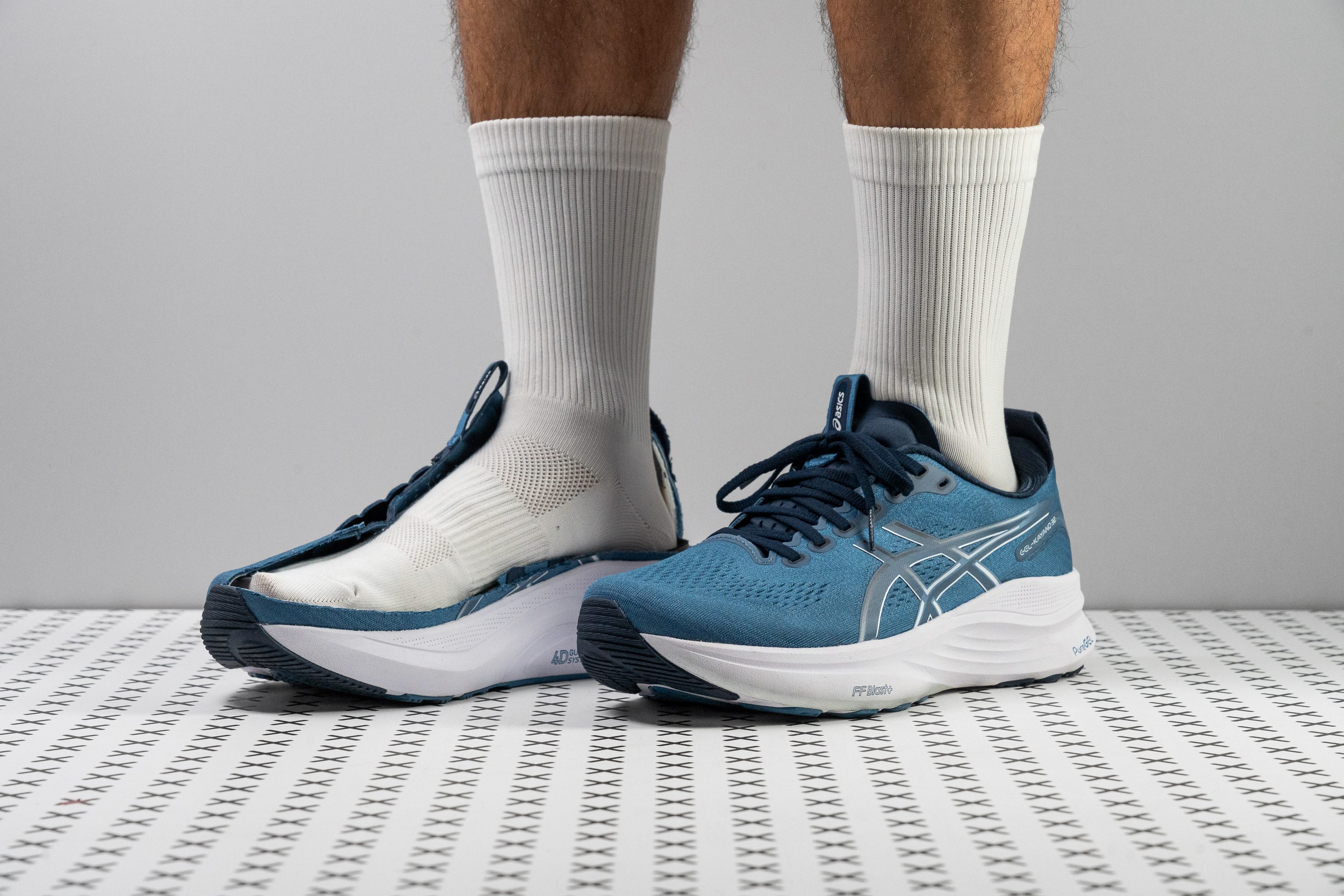













































What makes it the best?
The ASICS Gel Kayano 32 proved to be both supportive and comfortable during our wear tests. Indeed, it’s the best stability plantar fasciitis walking shoe we’ve tested in the lab, thanks to its rigid construction and 4D Guidance System. Each stride feels controlled and seriously protected, making long hours on foot feel like a breeze.
GK32’s core support is based on the 4D Guidance System, which provides impressive arch support and works in conjunction with the midsole sidewalls to keep us centred. In the lab, we attempted to twist the shoe manually, and it was uncompromising, earning a solid 5/5 in torsional rigidity.
The base is massive and ensures we find our footing securely. Our calliper shows it’s 119.8/97.2 mm wide, compared to the 114.3/90.7 mm average.
Balancing all the stiffness is a well-cushioned platform, which we measured at an above-average 39.9/30.6 mm. This feels immensely comfortable, and we like how the foam doesn’t sink even under heavy loads, making it perfect for those dealing with plantar fasciitis. The cushion reduces leg strain, backed up by high shock absorption levels of 133 SA (heel) and 116 SA (forefoot).
However, the shoe feels bottom-heavy with its thick midsole. Those who prefer more agility with each step should try lighter pairs.
Pros
- Amazing shock absorption
- Plush and breathable upper
- Made to last
- Dependable for most pronators
- Heavy-duty outsole with excellent grip
- Stable as a table
- Pillow-soft heel padding
- Improved fit
- Excellent build quality
Cons
- Not for soft-foam lovers
- Bad energy return
- Overpriced in Europe
Best lightweight walking shoes for plantar fasciitis
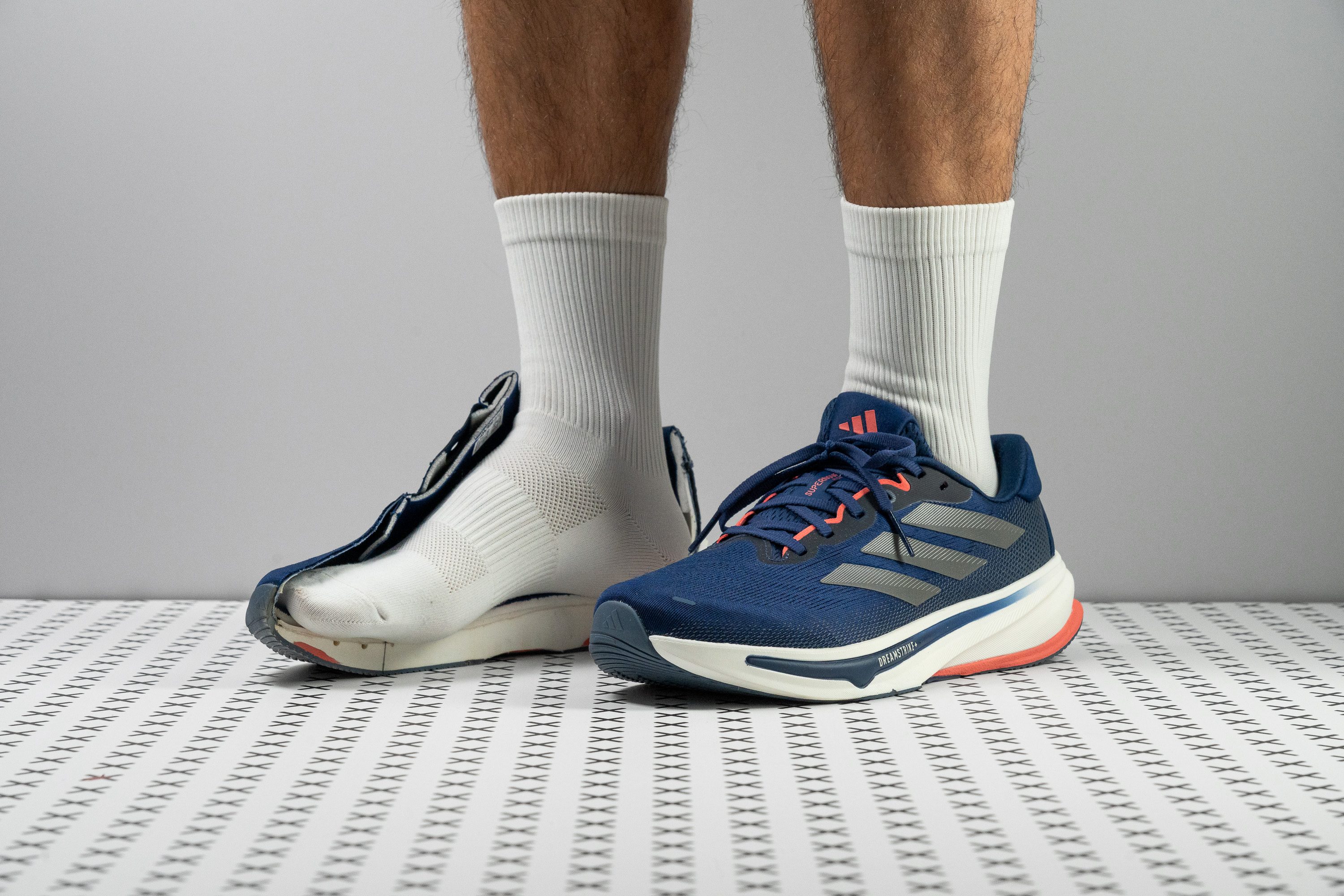

















































What makes it the best?
The Adidas Supernova Rise 2 sets a new standard for walking shoes that support plantar fasciitis, elevating it to the next level by keeping a low figure while offering comfort and gentle support. Further lab analysis cements its status as the best lightweight in this category.
To capture the lightness we felt during our strolls, we immediately took the shoes to the scale. We verified an airy build of 9.1 oz (257g), which is impressive for the support it offers. Its weightlessness is further enhanced by its low resistance to bending, as it emerged 51.7% more flexible than the standard in our bend test.
This pair manages discomfort by keeping its shock absorption high at 127 SA, despite its moderate 33.5/24.0 mm stack. It feels well-balanced, which helps relieve pressure off our arches and heels.
With small sidewraps in the rear, we recorded a comfortably high 4/5 heel counter stiffness, which helps guide our foot alignment. The midsole also includes Support Rods, which add a touch of stability to our strides.
We wish the tongue were gusseted, as this can help secure a locked-in fit for a more comfortable and stable ride. If this is a dealbreaker, other options are still available.
Pros
- Lighter than version 1
- Comfortable yet breathable upper
- Cold-proof PEBA midsole
- Stable ride with Support Rods
- Reflective accents for night visibility
- Maintains competitive price tag
- Responsive Dreamstrike+ foam
- Flexible, natural running experience
- Great for walking
Cons
- Outsole lacks Continental
- Not cushioned for forefoot strikers
- Still lacks a gusseted tongue
Walking shoes for plantar fasciitis with the best traction
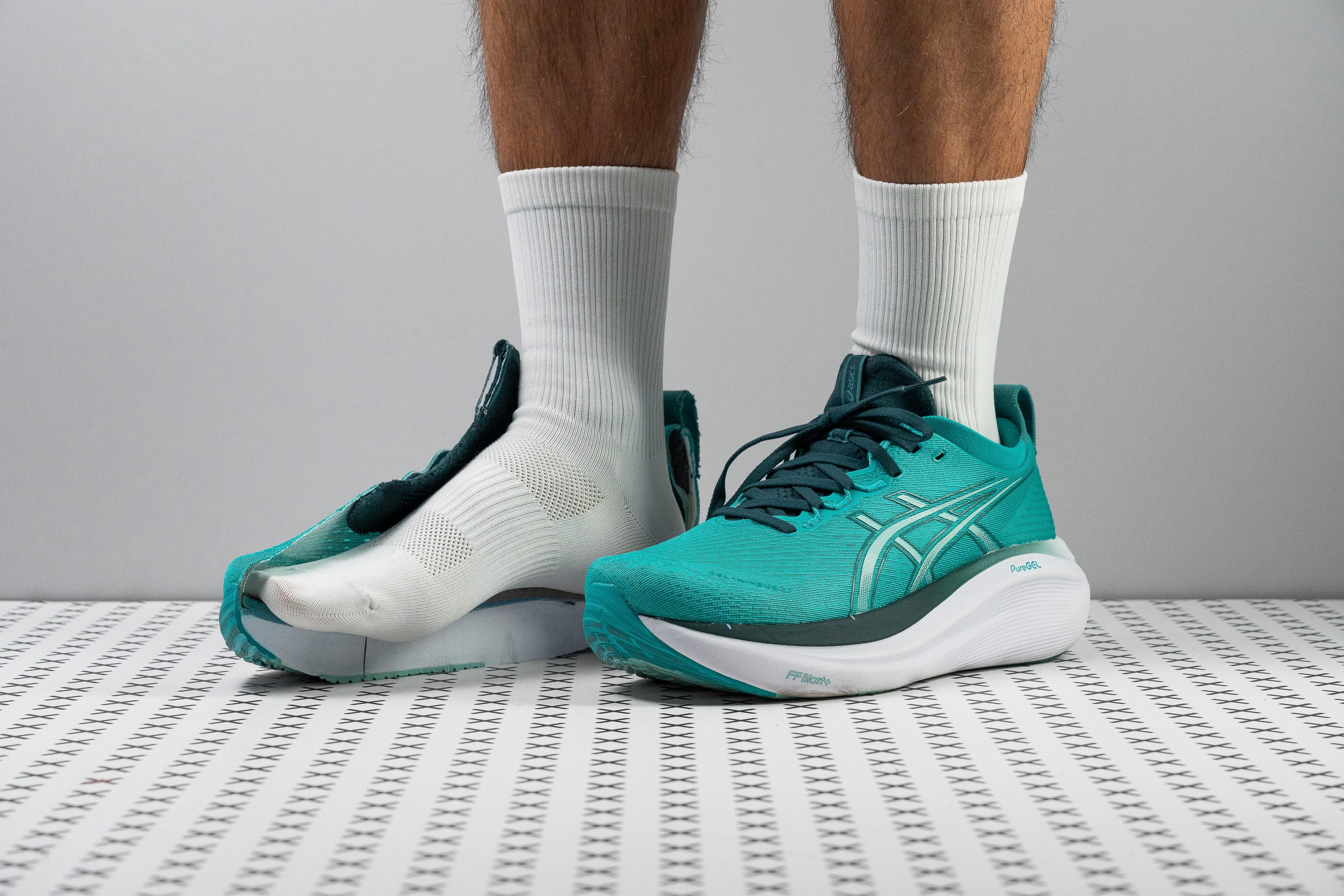


















































What makes it the best?
The ASICS Gel Nimbus 27 packs a lot in one shoe: plush cushioning, firm support, and an unwavering outsole. It elevates stability to the next level despite its sky-high stack, yet what impressed us most in the lab is its top-tier grip, making it our plantar fasciitis walking shoe with the best traction.
Nimbus 27 gave us full control of each step we took, even on slick surfaces. The Hybrid ASICSGRIP showed top performance in our wet-condition test, earning one of the highest scores we’ve seen in the lab at 0.84, 82.6% above average.
This pair didn’t skimp on cushioning and even pushed the limits with its 42.7/34.3 mm stack height, which relieves pressure off our feet since we have so much foam underneath. Shock absorption is top-notch at 136 SA in both the heel and forefoot.
Our well-planted feeling comes from the wider-than-average landing base of the shoe. Its generous space of 119.5/99.8 mm helps us find our footing securely. The midsole also retains a level of resistance to mitigate excessive motions. It received the maximum 5/5 torsional rigidity in our manual assessment.
All the good stuff Nimbus 27 offers is reflected in its heavy 10.5 oz (299g) build. Those who prefer a more weightless experience should go for other shoes.
Pros
- Even more foam underfoot!
- Premium-feel, breathable upper
- Fantastic stability
- Improved toebox with extra wiggle room
- Flexible knit tongue
- True maximalist comfort for recovery runs
- Amazing heel lockdown
- Top-tier grip
- Top-tier grip
Cons
- Feels bulky and heavy
- Minor price increase
- Lacks energy return
- Minimal outsole coverage
Best walking shoes for plantar fasciitis and wide feet
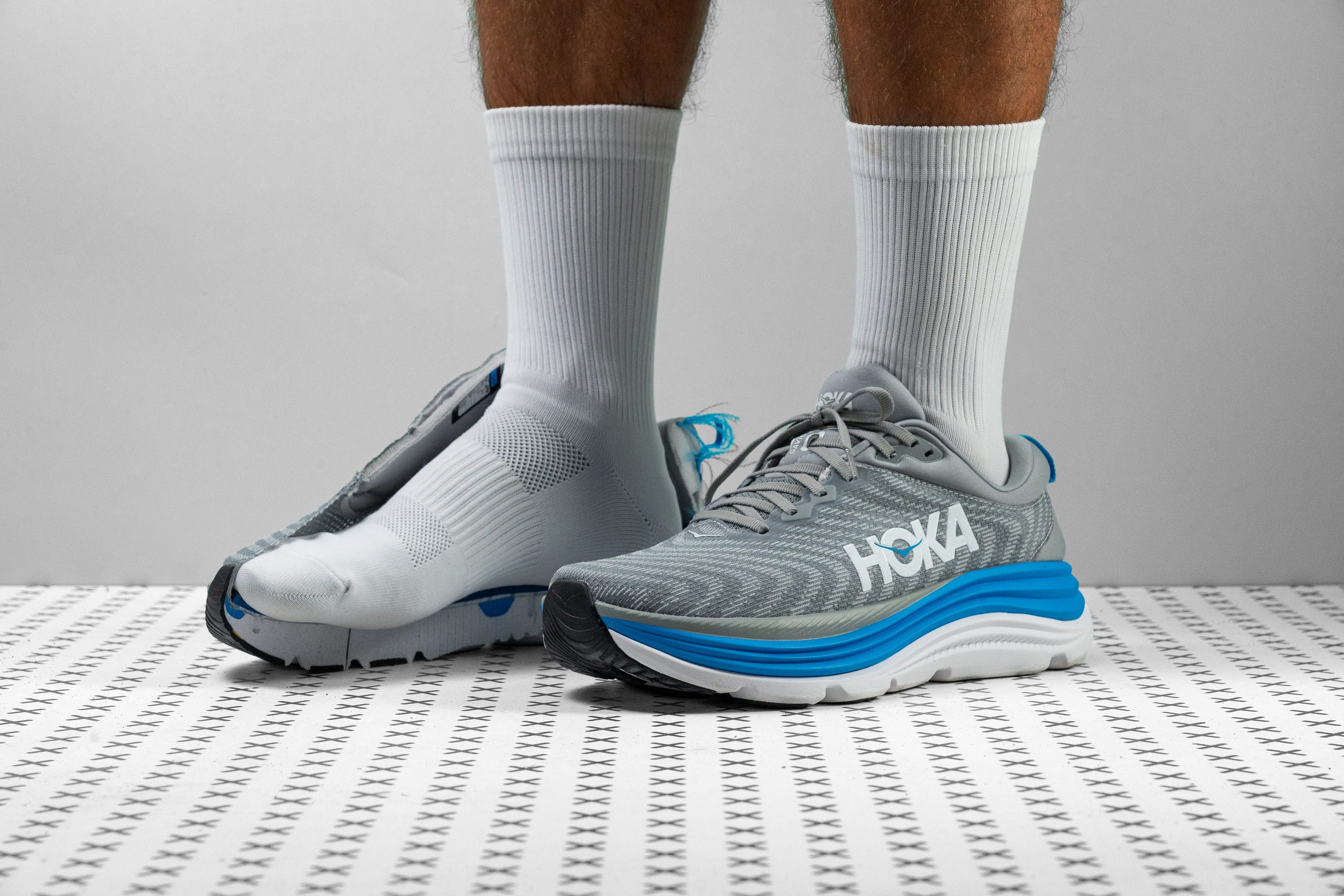


















































What makes it the best?
We searched for the best walking shoe for those with wide feet and plantar fasciitis concerns, and our tests and lab results led us to the Hoka Gaviota 5. With its accommodating fit, comfortable arch support, and subtle stability, we felt like we could walk endlessly since we experienced zero pain.
From the toebox to the midsole, all the measurements we took were above average. Our toes freely splayed in the 101.8 mm toebox that barely tapers to the 83.1 mm front area. In the forefoot and heel, they emerged a mind-blowing 11.0/15.9 mm wider than the average base, ensuring we had room to find our balance.
Beneath our feet, a delightful cushioning awaits. Slicing it into half reveals a dual-density set-up: a plush 12.9 HA layer for comfort and a firmer 22.0 HA foam for controlled and stable steps. Altogether, our feet enjoyed the foam's sensation without any localised tension.
Gaviota 5 also features the H-Frame, which adds structure to the midsole to avoid unwanted movements. Our manual assessment confirms a high torsional rigidity score of 4/5. However, longitudinally, the midsole emerged 14.3% stiffer than average too, which takes away the natural feel and comfort some people prefer. Those who want more flexible shoes should look for other options.
Pros
- Remarkably stable
- Breathable and comfortable upper
- Lightweight for its size
- Good stability option for forefoot strikers
- Ideal for wide feet
- Excellent for long runs
- Excellent for long runs
Cons
- Low drop might pose issues for heel strikers
- Performs poorly in colder conditions
- Not for narrow feet
- Midsole feels flat
Best budget walking shoes for plantar fasciitis
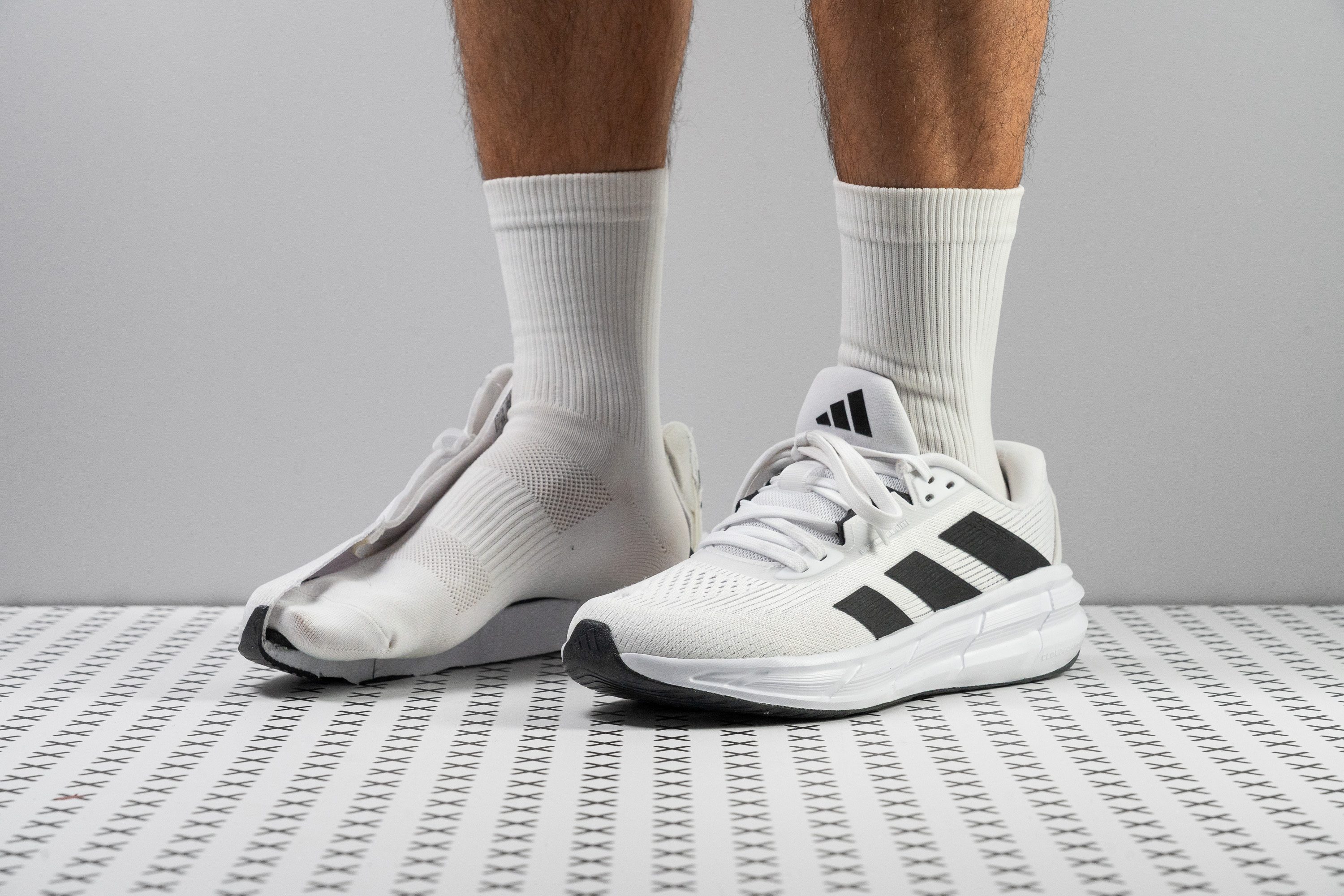












































What makes it the best?
At £80, we believe the Adidas Questar 3 is worth every penny because our lab tests and walks show it seamlessly combines stability and versatility. Its wide and structured midsole offers firm support while its flexible and breathable build brings lasting comfort—making it our best budget walking shoe for those with plantar fasciitis.
Despite being 48.6% cheaper than the average walking shoe, Questar 3 goes big on support. It features a wide 95.7 mm heel for secure steps, the first to land when walking. Its stiff heel counter keeps us centred without too much discomfort, verified by its 4/5 stiffness score in our assessment.
Questar 3 avoids any form of twisting through its maximum torsional rigidity (5/5). However, it drives forward movement with its bendable midsole. In our flex test, it was 5.3% more pliable than average, making it ideal for activities beyond walking.
Scoring 4/5 in our smoke test, it’s the ideal shoe for year-round use. It’s breathable enough for the summer, and can retain some warmth during colder seasons.
While it’s light in the pocket, it’s sadly heavy on the feet at 10.4 oz (295g). If weightlessness is a top priority, we suggest skipping this pair.
Pros
- Amazing value for money
- Excellent durability from heel to toe
- Breathable upper
- Stable ride
- Comfortable fit
- Great for casual wear too
- Ideal for heel strikers
Cons
- Rigid build
- Needs to lose some weight
- Subpar grip
- Subpar grip
Do you need shoes for plantar fasciitis?
Yes, if you have plantar fasciitis.
It is well known for the pain that happens in the heel area and might even spread to the midfoot area. The pain is present because the fascia that connects your heel to your toes becomes inflamed, usually because of overuse.
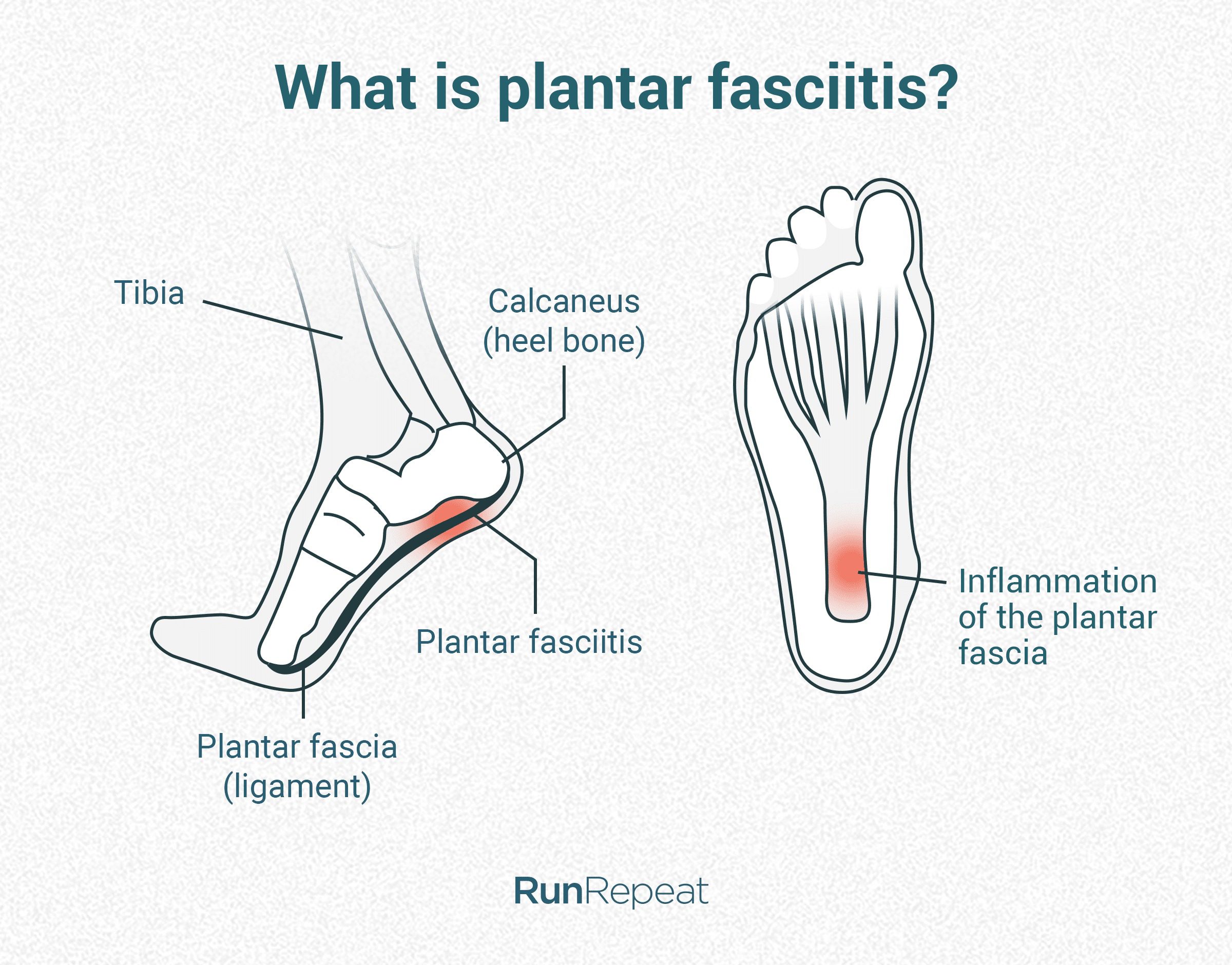
The best thing to do is to see a specialist about it - better than trying to self-diagnose. There are numerous possible causes of heel pain.
Symptoms of plantar fasciitis
In this review of the most current scientific literature on plantar fasciitis, the symptoms are listed as follows:
- A severe heel pain in the morning or after a rest period
- The heel pain that gets worse with weight bearing
- Pain might spread from heel to the midfoot
- Soreness when palpating plantar fascia
- Discomfort when you bend your big toe by hand (passively)
How to find the best walking shoes for plantar fasciitis
If you’re experiencing plantar heel pain you might experience difficulty with footwear comfort, fit, and choice, as this research has shown.
Don’t be discouraged, here’s the list of shoe features to help with the pain.
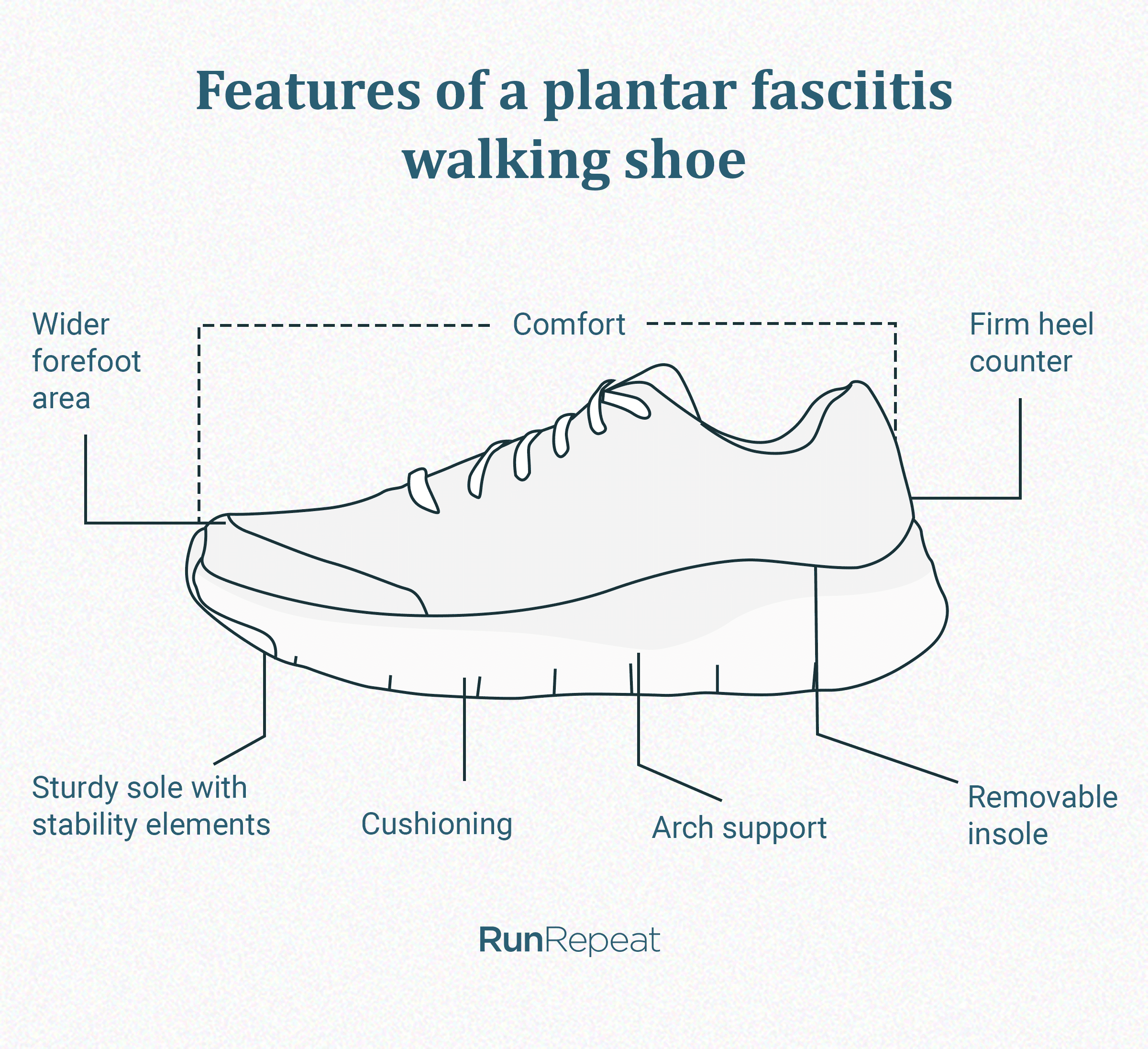
These are the things you should look for in a shoe in case you have plantar fasciitis. The idea behind these features is to find a shoe that minimises impacts when your foot hits a hard surface.
First and foremost, comfort. The shoe should be comfortable overall! Aside from that, a shoe appropriate for plantar fasciitis should have the following features:
|
Features of a plantar fasciitis walking shoe |
|
|
Wide and stable sole |
Provides the needed stability and sure-footedness. |
|
Sufficient and moderately soft cushioning |
Decreases the impact forces while walking. The heel area should have additional cushioning to take the strain off the plantar fascia ligament. |
|
Firm and supportive heel counter |
Keeping the heel steady minimises additional stretching of the plantar fascia. |
|
Spacious toebox |
So that your toes don’t feel squeezed or pressured. |
|
Arch support (optional) |
If you also have flat feet and overpronation. |
|
Removable insoles (optional) |
You might need this option in case you go for special insoles for plantar fasciitis. |
Not all these features are a must. Comfort comes first. Everything else is there to eliminate/lessen the pain and make your walking a comfortable experience.
You should avoid minimalist or barefoot shoes because they lack most of the abovementioned features.
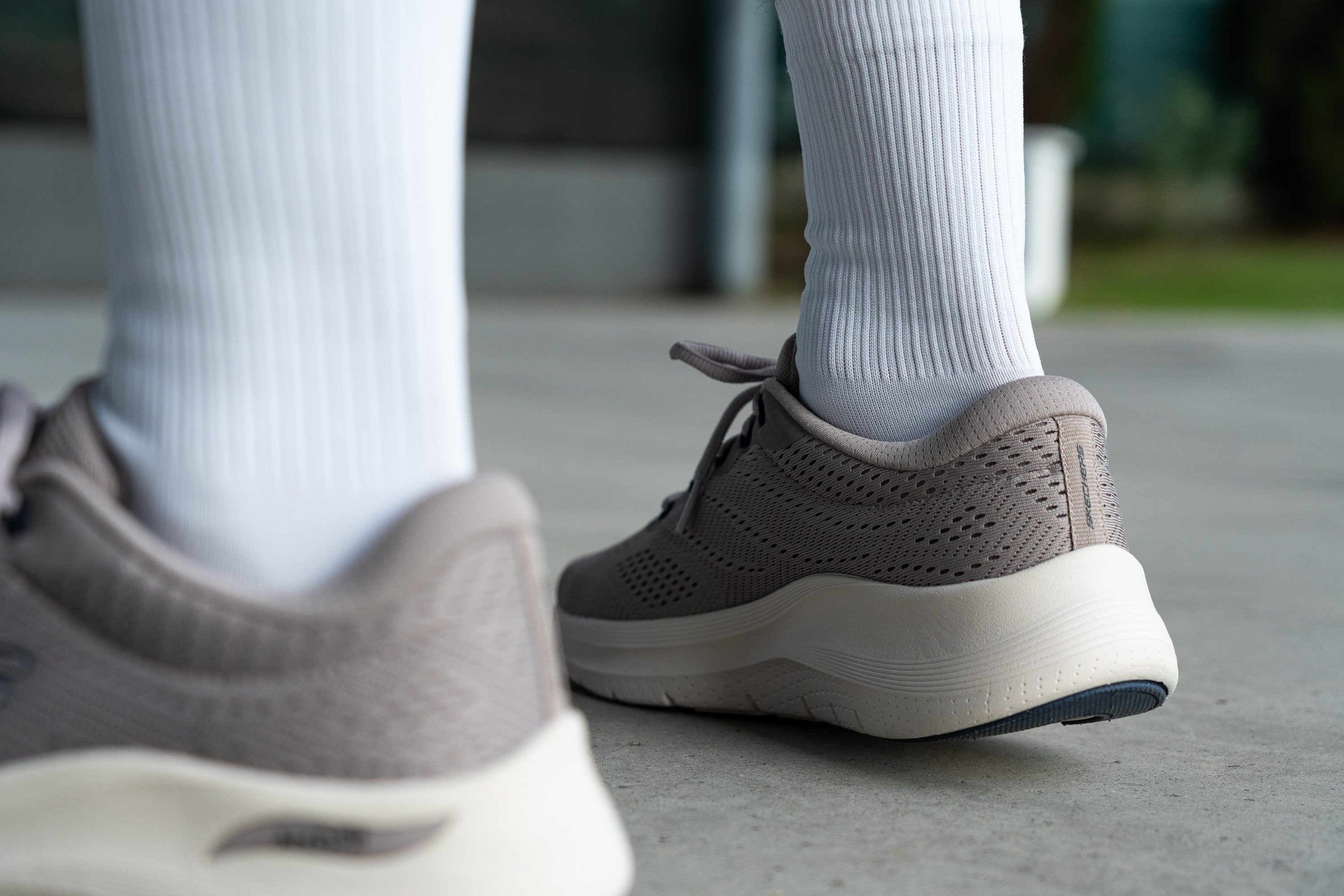
Here is an overview of walking shoes that meet the criteria listed above and can be recommended for plantar fasciitis. Each criterion is elaborated in detail in the sections below.
Wide and stable sole: a must for plantar fasciitis
When you suffer from foot pain, the last thing you want is shaky and wobbly footwear. You will only feel at ease when stepping on a stable platform that keeps you surefooted.
That’s why we put each walking shoe through a series of stability tests before we can recommend it for plantar fasciitis.
The most supportive shoes will have the following characteristics:
- high torsional rigidity (it is hard to twist the shoe sideways)
- very wide platform (in the heel, midfoot, and forefoot)
We perform a manual test to check the torsional stiffness of each shoe. We then rate it on a 1-5 scale, where 5 is the stiffest. A shoe must have a score of at least 3 to be considered suitable for plantar fasciitis.
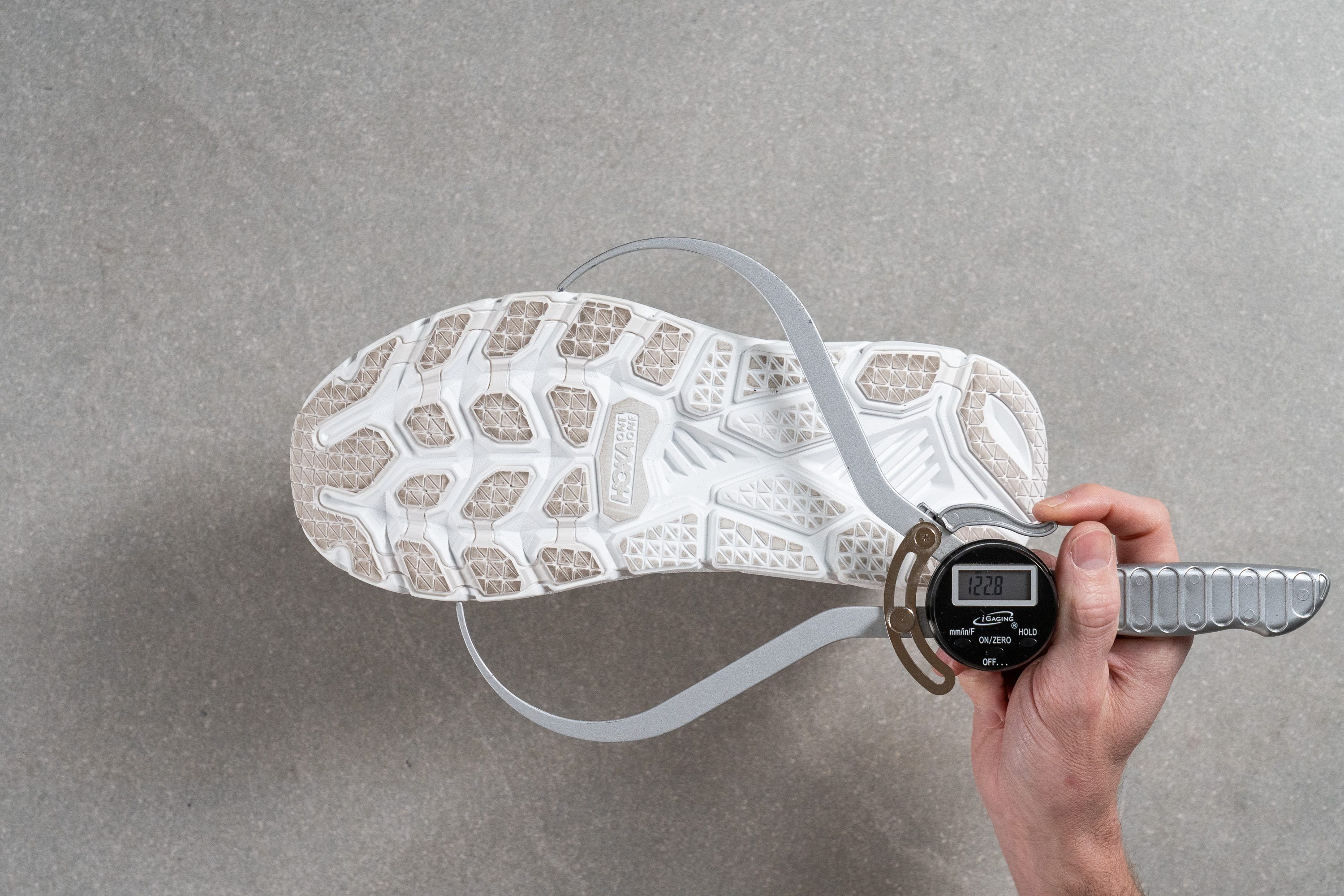
Using a calliper, we also measure the width of the shoe’s midsole. For consistent results, we always measure it in the widest areas of both the forefoot and the heel.
Putting together our lab findings, here is an overview of walking shoes that we consider suitable for plantar fasciitis:
To broaden your options, we also include running shoes with the same parameters that can be comfortably used for walking.
You can find even more options here.
Arch support in walking shoes for plantar fasciitis
It is possible that in addition to plantar fasciitis, you also have flat feet and/or overpronation. You should consider a more supportive walking shoe if:
- your feet have no arches when you sit or stand
- your feet and ankles tend to roll inwards a lot
- your shoes wear out faster on the inner side
When in doubt, we highly recommend consulting your doctor.
But if you recognise yourself in all three cases listed above, there is a high chance that you need a stability shoe.
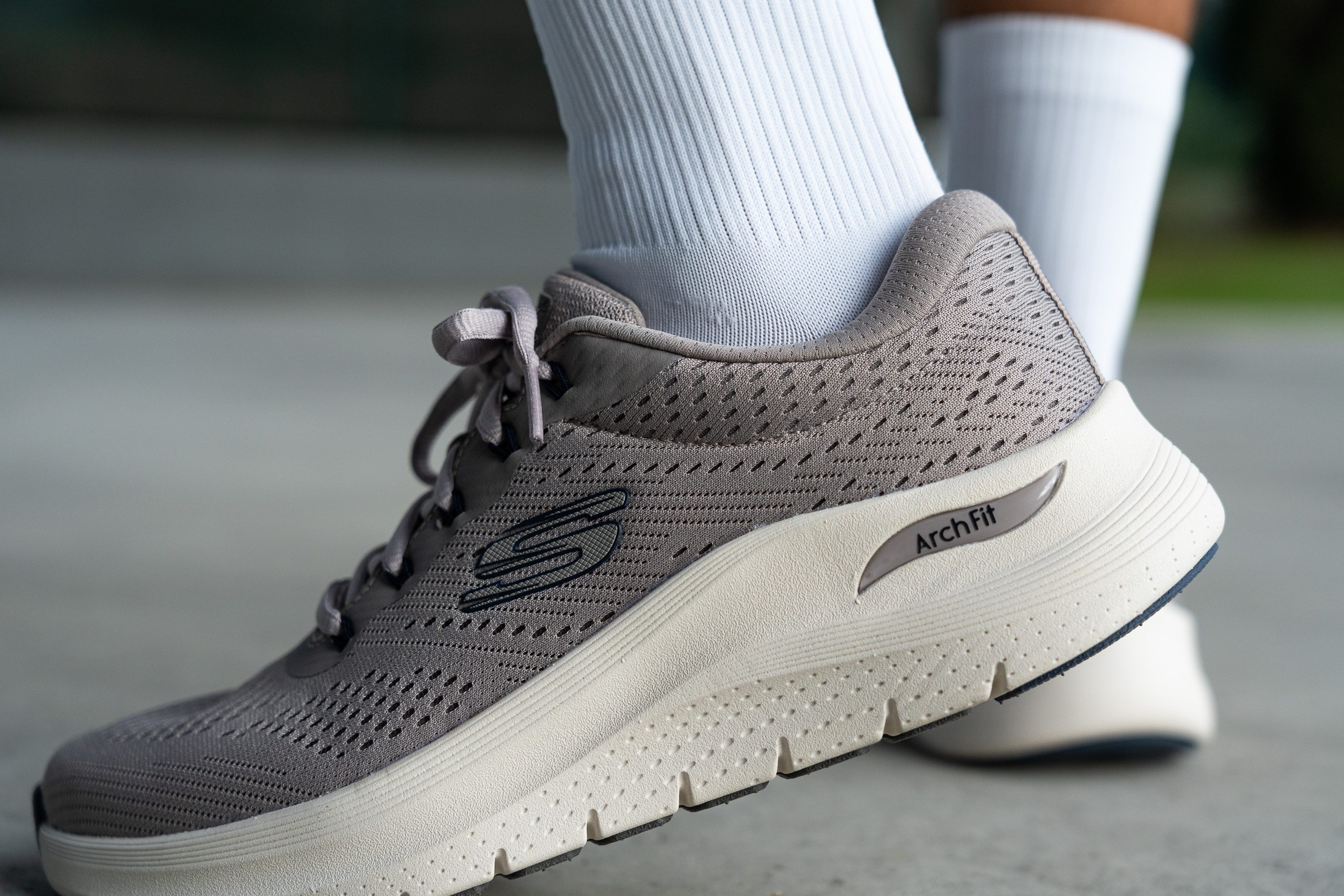
Choosing the right cushioning in walking shoes for plantar fasciitis
To be recommended for plantar fasciitis, a shoe must have enough cushioning to provide impact protection and take the pressure off the heel.
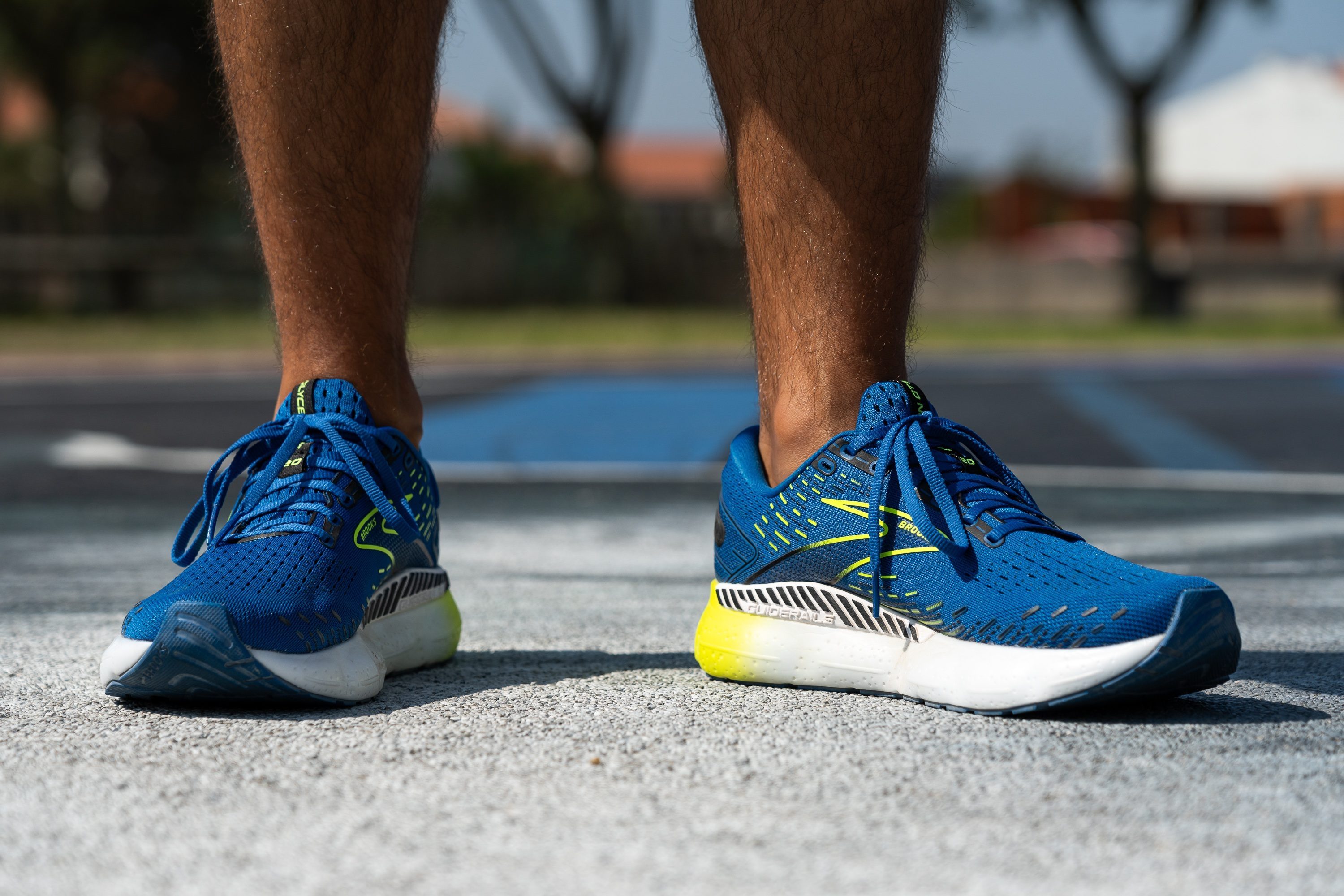
A study with 101 participants revealed that 83.2% of people with plantar fasciitis were wearing inappropriate shoes for their condition. These were shoes with a minimal heel height or hard, non-cushioned insoles without built-in arch support.
On a positive note, another study showed that 95% of patients who wore max-cushioned shoes reported that the footwear helped in their recovery process.
Shock absorption and heel-to-toe drop
But what is considered good cushioning for plantar fasciitis?
While there is no specific guideline, we believe it is safe to recommend at least:
- 100 SA of shock absorption
- 8 mm of heel-to-toe drop*
*The drop indicates the elevation of the heel above the toes. It is the difference in height between the heel stack and the forefoot stack.
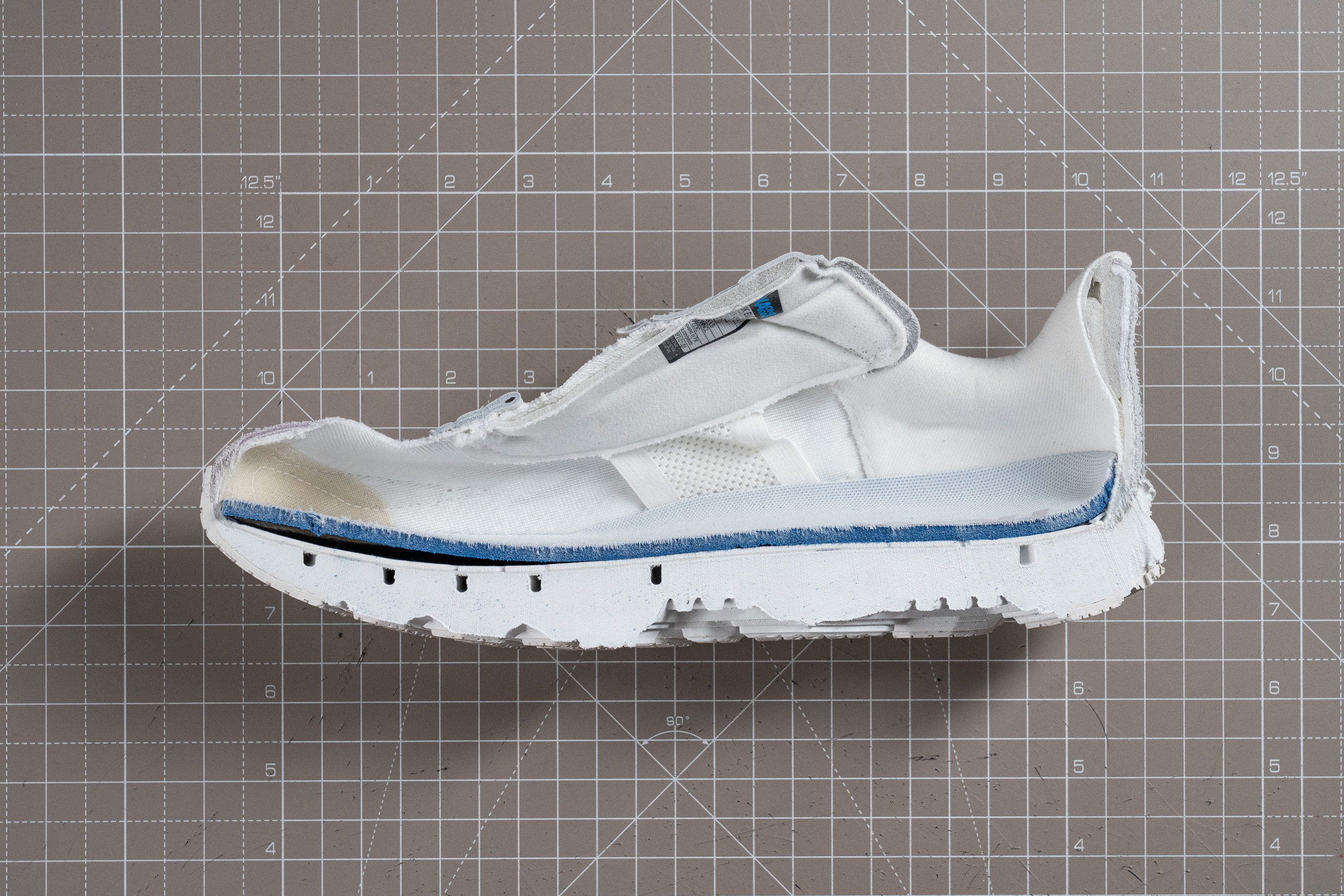
To make your life easier, we measure every walking shoe’s shock absorption in our lab. We follow the acclaimed ASTM F1976 standard and utilise specialised machinery to measure precisely how much impact is absorbed by the shoe's platform.
The higher the SA reading, the more protection you can expect.
Depending on personal preference, you can opt for a slightly higher or lower heel stack and drop. You might as well stick to shoes with average measurements to be on the safe side.
You can also find more options among running shoes that are suitable for walking and meet the criteria for plantar fasciitis.
Midsole softness
On one hand, you need a touch of softness to dampen the impact upon landings. On the other hand, an overly plush shoe may aggravate the plantar fascia.
The common ground is to choose moderately soft or even a bit firm cushioning.
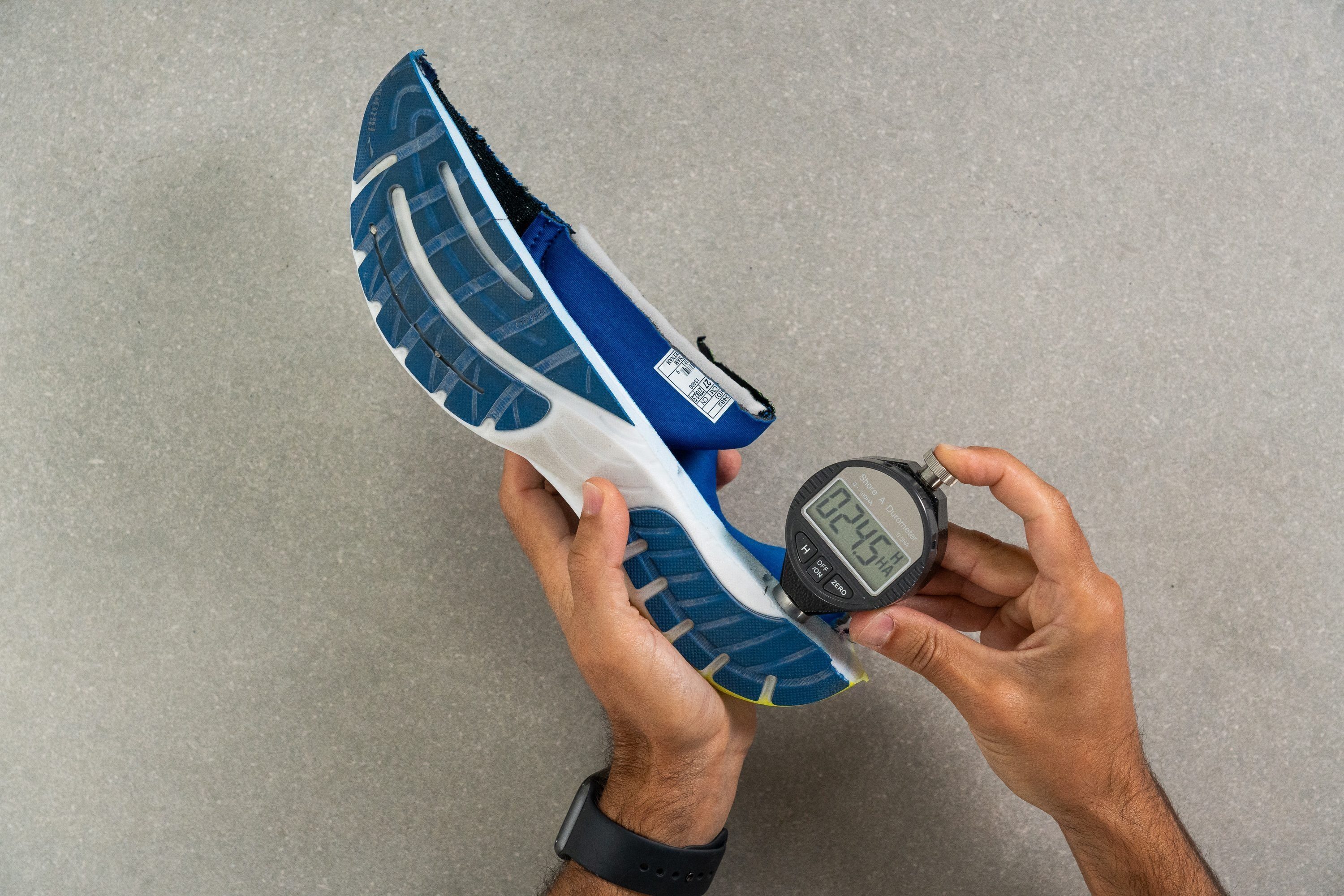
In the lab, we cut all tested shoes in half and measure their foam softness with an HA durometer to find out which walking shoes could be suitable for plantar fasciitis.
We recommend choosing from shoes with an HA reading between 20 and 30:
The lower the HA number, the softer the cushioning. You can choose plusher or firmer based on your preference.
Do check the heel counter too
The lack of proper support at the rearfoot may lead to excessive shifting of the heel and ankle. This, in turn, is likely to exacerbate the heel pain.
We perform a manual squeeze-and-push test to check how structured is the heel counter on each walking shoe. The stiffness is rated on a 1-5 scale, where 5 is the stiffest.
A heel counter must score at least 3 in this test to be considered appropriate for plantar fasciitis.
Make sure there is enough space in the toebox
Even when you find a shoe with the most ideal support and cushioning, the experience can be ruined by a tight-fitting upper. That’s why it is critically important to get the right shoe size in your day-to-day walking shoes. In addition to getting the size (length) right, you should also check if the toebox has enough room for your toes.
Once the gel mould has hardened, we take out our digital calliper and start measuring!
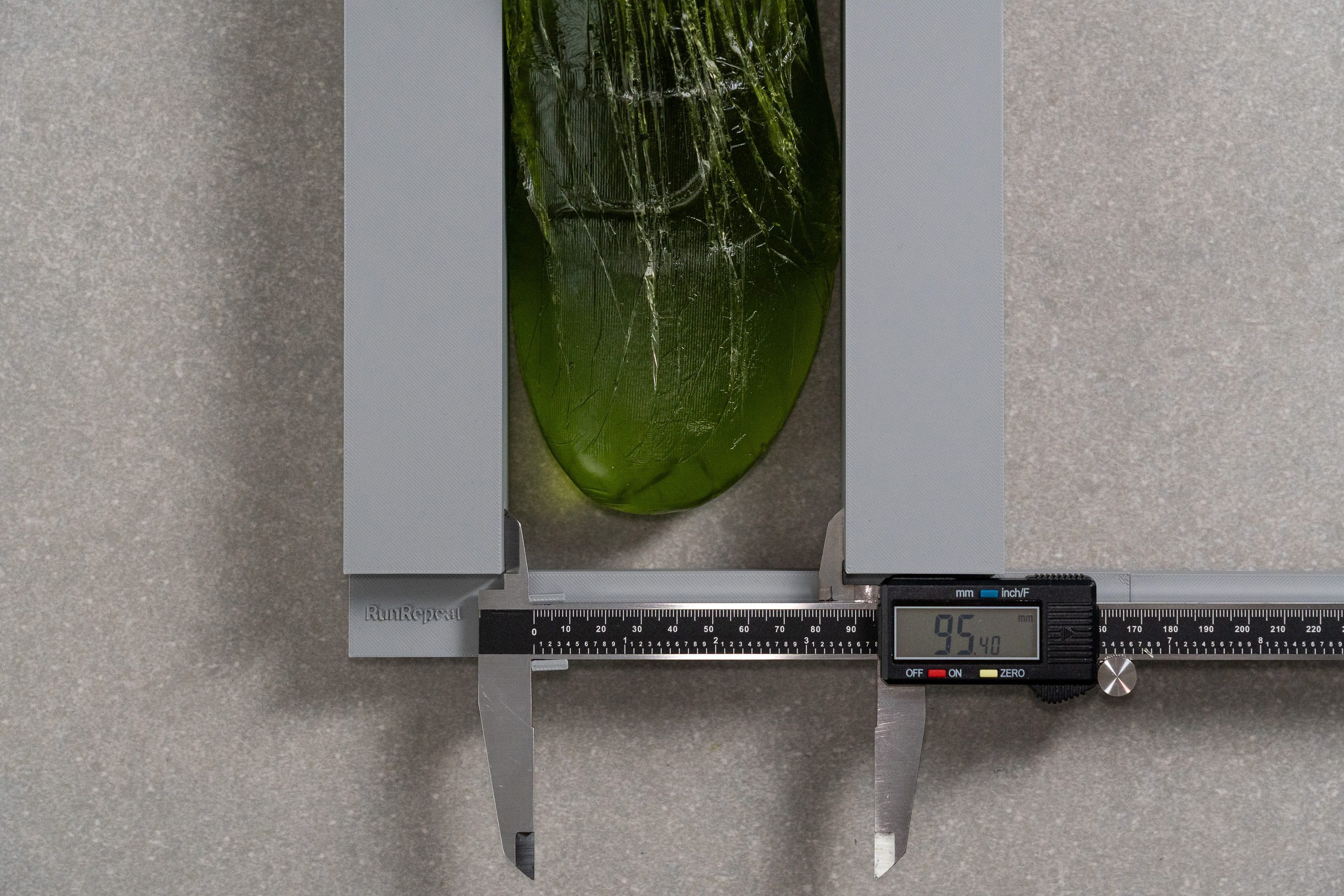
If the shape of your feet dictate this is where you need the most room, look no further.
However, if it is higher up toward the tip of the shoe where you need more room, look at the width measurement at the big toe.
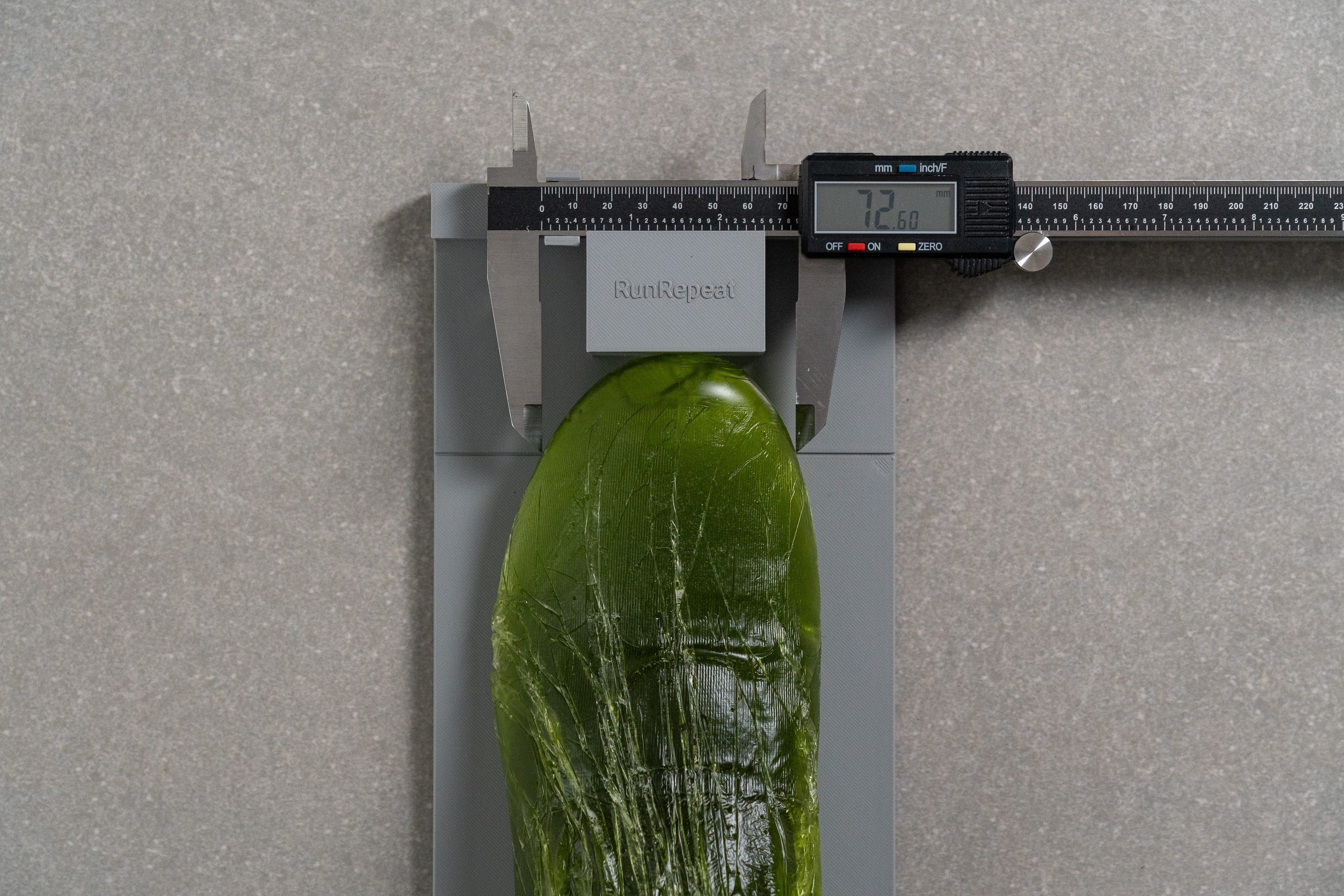
Shoes that are wide in this area have a rounder toebox, while those that are narrow here we usually call pointy.
Having enough space in the toebox is not only about the width but height as well. No body loves the idea of a black toenail!
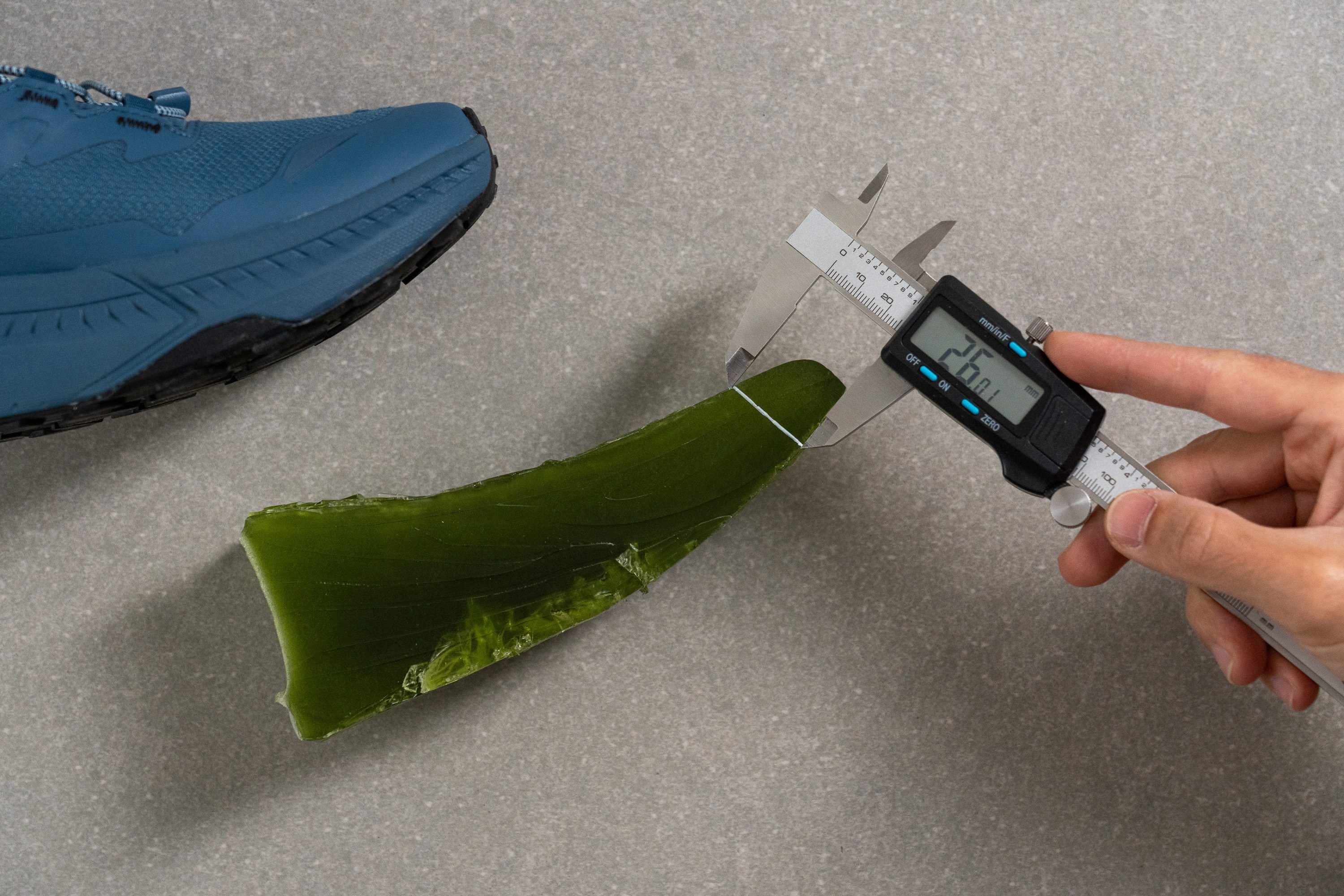
Are rocker shoes good for plantar fasciitis?
They are. In fact, podiatrists often prescribe shoes with a stiff rocker profile to help alleviate the pain associated with plantar fasciitis.
The curved shape of such shoes acts like a rocking chair for the foot. It makes heel-to-toe transitions much smoother and easier, distributing the pressure evenly across the foot.
They also make the ride feel more propulsive as the rocker encourages the foot to roll forward.
However, there are a couple of caveats.
A rocker-bottom walking shoe may not be a panacea for plantar fasciitis. Even though such shoes can be used as part of the treatment, they only help to ease the pain. Do consult with your doctor first.
Another downside is that rocker shoes can take some getting used to, especially if the curve is aggressive. Standing in some shoes can feel tricky at first.
We have tested a number of rockered walking shoes to find out which ones meet our criteria for plantar fasciitis.
Treatment of plantar fasciitis
It’s important to consult your specialist about possible treatments for your condition. The treatments that should likely be attempted first are those that are low-cost and low-risk such as stretching of the plantar fascia and/or Achilles tendon, education about the condition, and prefabricated orthotics (as explained here).
This, however, is a general overview of how the treatment algorithm looks like:
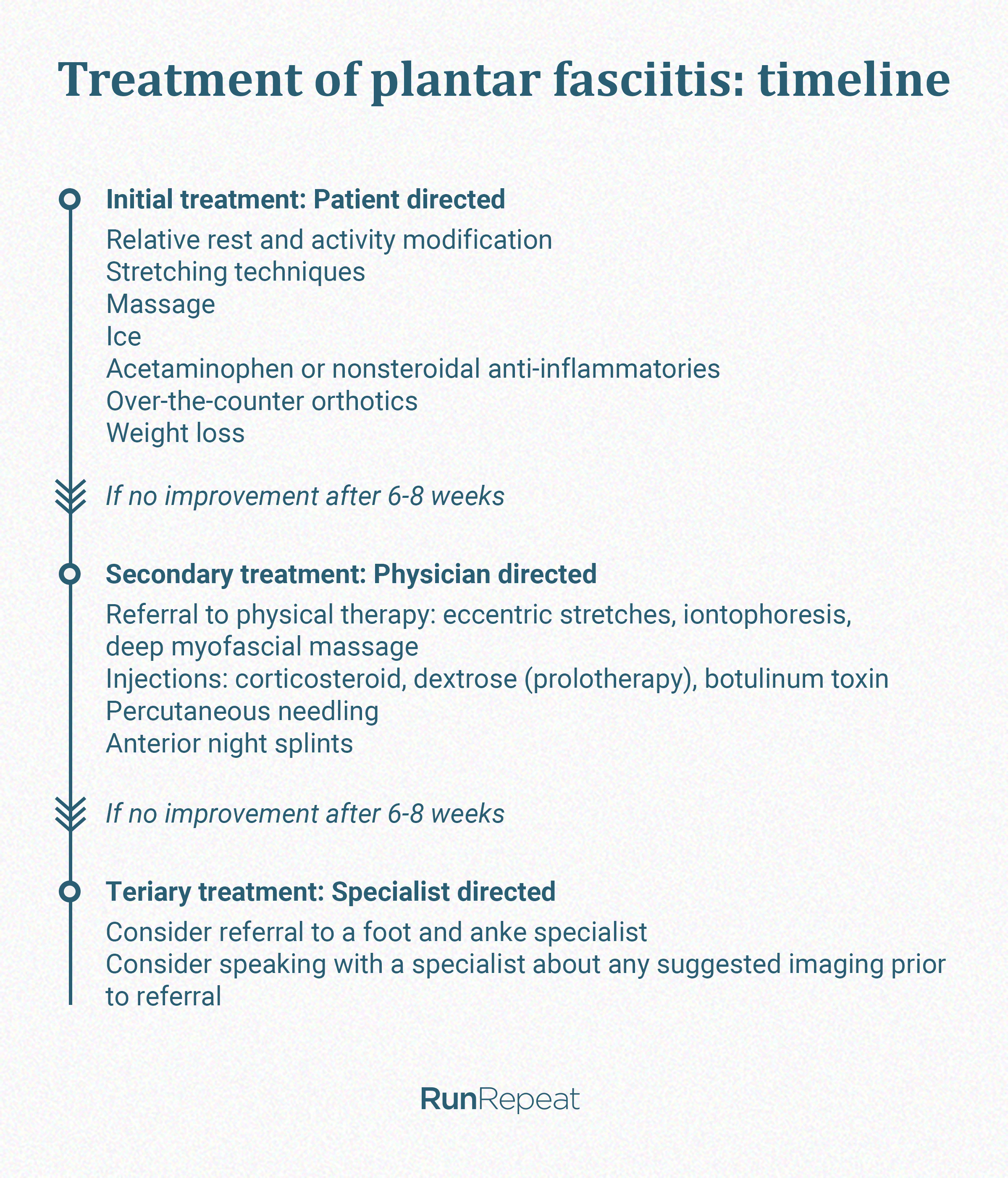
If you’re dealing with chronic plantar fasciitis, this research offers an in-depth comparison between different inserts and insoles.
Don’ts for people with plantar fasciitis
1. What happens if you ignore plantar fasciitis?
It will go from acute to chronic pain. It might even lead to pain in other body parts, because you’ll start walking differently in order to lessen the pain by changing the impact in the feet. This way, compensation will happen and other body parts will light up. In order to avoid new discomfort and pain, it’s important to treat plantar fasciitis while it’s in the acute phase.
2. Can I walk on the treadmill if I have plantar fasciitis?
Walking on a treadmill might make your plantar fasciitis worse. Basically, you’re doing more steps in a shorter period of time. The best suggestion for plantar fasciitis is to stop repetitive motion with impact forces in the heel.
Some even advise activities such as elliptical machine or stationary cycling until the symptoms resolve, as shown in this study.
3. Can I wear running shoes for walking if I have plantar fasciitis?
Depends on the purpose. If you’re doing quick power walks, running shoes might do. Pay attention to how your feet feel. However, if you’re looking for shoes for casual walks, you should look for models made especially for walking. To read more on the differences between running and walking shoes, read our in-depth guide on walking shoes.
4. Can I walk barefoot if I have plantar fasciitis?
You should not walk barefoot. Plantar fasciitis means your plantar tendon is under too much pressure and you need stability features that shoes offer to help decrease both pain and pressure.
5. What causes plantar fasciitis?
The main cause hasn’t been discovered scientifically. However, there are numerous risk factors:
Intrinsic risk factors:
- Obesity
- Pes planus (flat feet)
- Pes cavus (high-arched feet)
- Shortened Achilles tendon
- Overpronation (inward roll)
- Limited ankle dorsiflexion
- Weak intrinsic muscles of the foot
- Weak plantar flexor muscles
Extrinsic risk factors:
- Poor biomechanics or alignment
- Deconditioning
- Hard surface
- Walking barefoot
- Prolonged weight bearing
- Inadequate stretching
- Poor footwear


